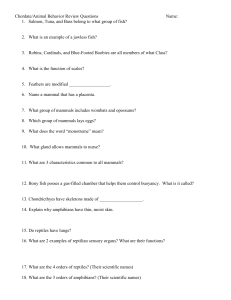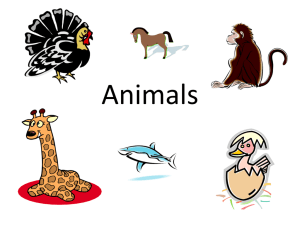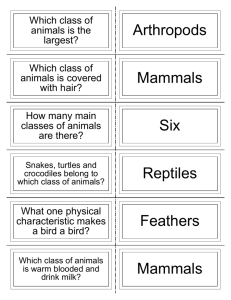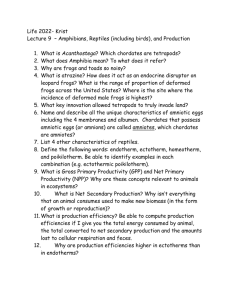Vertebrate Survey 2009 Amphibians
advertisement
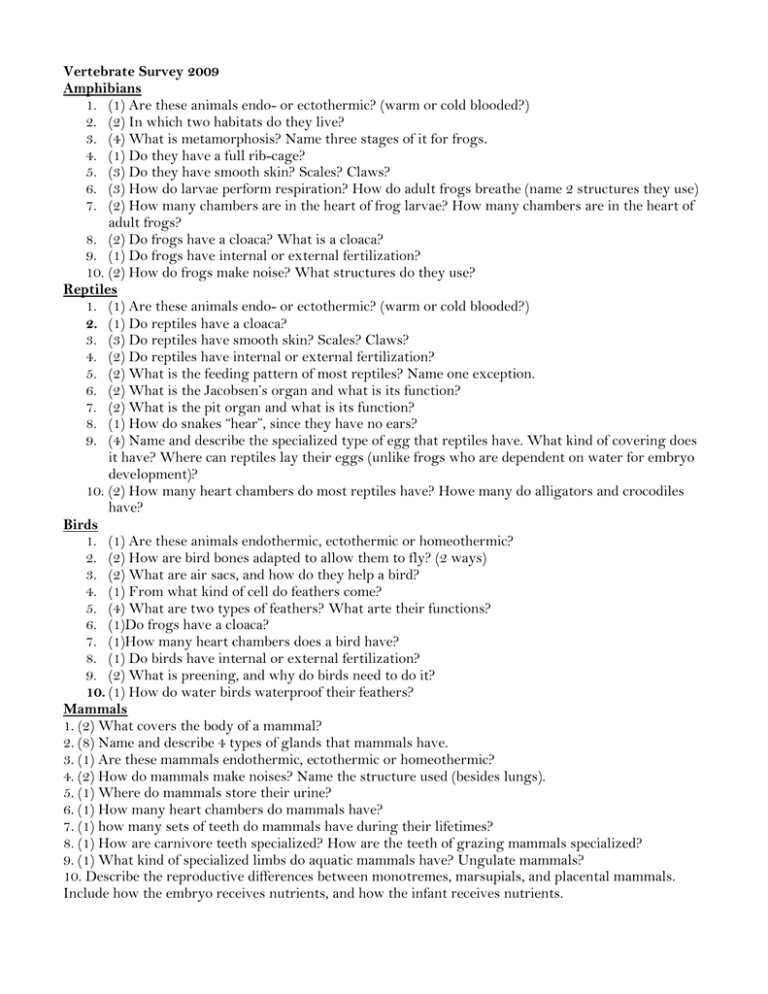
Vertebrate Survey 2009 Amphibians 1. (1) Are these animals endo- or ectothermic? (warm or cold blooded?) 2. (2) In which two habitats do they live? 3. (4) What is metamorphosis? Name three stages of it for frogs. 4. (1) Do they have a full rib-cage? 5. (3) Do they have smooth skin? Scales? Claws? 6. (3) How do larvae perform respiration? How do adult frogs breathe (name 2 structures they use) 7. (2) How many chambers are in the heart of frog larvae? How many chambers are in the heart of adult frogs? 8. (2) Do frogs have a cloaca? What is a cloaca? 9. (1) Do frogs have internal or external fertilization? 10. (2) How do frogs make noise? What structures do they use? Reptiles 1. (1) Are these animals endo- or ectothermic? (warm or cold blooded?) 2. (1) Do reptiles have a cloaca? 3. (3) Do reptiles have smooth skin? Scales? Claws? 4. (2) Do reptiles have internal or external fertilization? 5. (2) What is the feeding pattern of most reptiles? Name one exception. 6. (2) What is the Jacobsen’s organ and what is its function? 7. (2) What is the pit organ and what is its function? 8. (1) How do snakes “hear”, since they have no ears? 9. (4) Name and describe the specialized type of egg that reptiles have. What kind of covering does it have? Where can reptiles lay their eggs (unlike frogs who are dependent on water for embryo development)? 10. (2) How many heart chambers do most reptiles have? Howe many do alligators and crocodiles have? Birds 1. (1) Are these animals endothermic, ectothermic or homeothermic? 2. (2) How are bird bones adapted to allow them to fly? (2 ways) 3. (2) What are air sacs, and how do they help a bird? 4. (1) From what kind of cell do feathers come? 5. (4) What are two types of feathers? What arte their functions? 6. (1)Do frogs have a cloaca? 7. (1)How many heart chambers does a bird have? 8. (1) Do birds have internal or external fertilization? 9. (2) What is preening, and why do birds need to do it? 10. (1) How do water birds waterproof their feathers? Mammals 1. (2) What covers the body of a mammal? 2. (8) Name and describe 4 types of glands that mammals have. 3. (1) Are these mammals endothermic, ectothermic or homeothermic? 4. (2) How do mammals make noises? Name the structure used (besides lungs). 5. (1) Where do mammals store their urine? 6. (1) How many heart chambers do mammals have? 7. (1) how many sets of teeth do mammals have during their lifetimes? 8. (1) How are carnivore teeth specialized? How are the teeth of grazing mammals specialized? 9. (1) What kind of specialized limbs do aquatic mammals have? Ungulate mammals? 10. Describe the reproductive differences between monotremes, marsupials, and placental mammals. Include how the embryo receives nutrients, and how the infant receives nutrients.
